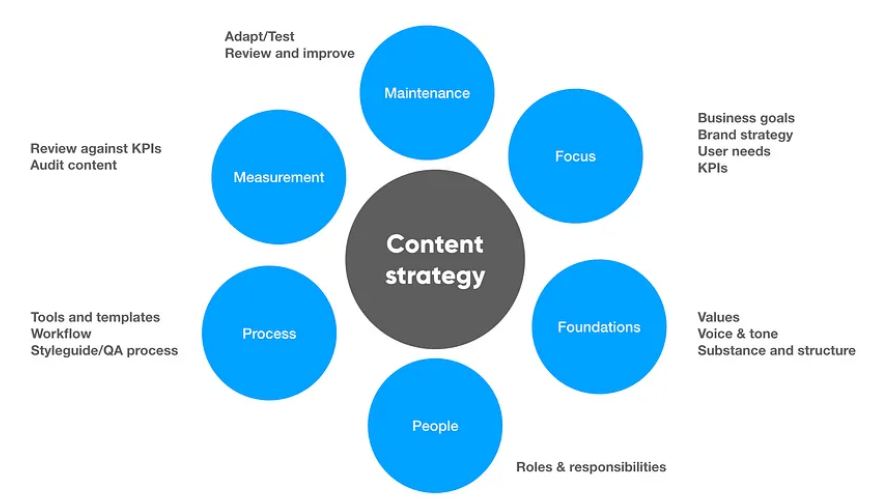Confused about content strategy vs content marketing strategy? This mix-up is common and can lead to ineffective content and marketing efforts, directly impacting your ability to engage and convert your audience.
Content strategy lays the foundation, focusing on creating, managing, and structuring content, while content marketing strategy is all about using that content to attract, engage, and delight your audience, driving profitable actions.
This article breaks down the top 5 differences to help you clearly understand how to use each strategy effectively. By grasping these concepts, you can enhance your content’s reach and impact, ensuring it not only meets your audience’s needs but also supports your business goals.
- Core Purpose and Focus: Unpacking the Essentials of Content Strategy vs Content Marketing Strategy
- Target Audience and Engagement: Recognizing and Influencing Your Customers
- Content Creation and Distribution: Building Authority vs. Generating Leads
- Measurement of Success: Evaluating KPIs and Setting Benchmarks
- Integration with Overall Marketing Strategy: A Seamless Alignment
- Don’t Miss Out on Your Pathway to Success with Flying V Group
- FAQs
Core Purpose and Focus: Unpacking the Essentials of Content Strategy vs Content Marketing Strategy
In the era of digitalization, as a marketer or business, you cannot be confused with the dilemma of ‘content strategy vs. content marketing strategy.’ They are critical to shaping a brand’s online persona and customer engagement.
Raw text is the lifeblood of all marketing campaigns, which is why content strategy and content marketing strategies play such critical roles. Although closely linked, they serve disparate purposes and focus on different aspects of the customer journey and business objectives.

Content Strategy – Laying the Foundation
A content strategy chiefly:
- Organizes, creates, and manages valuable content in alignment with business goals.
- Focuses on the “why” behind generating content; it’s about the conception, delivery, and governance of the content.
- Centers around the brand story and how to effectively communicate it to different stakeholders.
- Structures the voice and tone of the brand, defining how to connect with the target audience.
Content Marketing Strategy – Building the Edifice
A content marketing strategy, on the other hand:
- Builds on the content strategy, transforming valuable content into marketing assets.
- Focuses on the “how” of content: how to use and distribute it to attract, engage, and retain customers.
- Concentrates chiefly on buyer personas, customer journey mapping and distribution channels that fulfill marketing needs.
- Measures the performance of content based on responses from viewers and uses these insights to get closer to marketing goals.
In essence, the content strategy serves as a blueprint for why, what, and who, whereas a content marketing strategy details how and where the content will be shared. Each strategy hones different customer journey phases to achieve the overall business and marketing objectives.
Target Audience and Engagement: Recognizing and Influencing Your Customers
Distinguishing between content strategy vs content marketing strategy involves understanding their unique approaches to identifying and influencing target audiences. Both intersect in their commitment to audience engagement but diverge in the methods employed.
Identifying the Target Audience
- Content Strategy: Focuses on understanding the broader organizational demographics and psychographics. It mainly entails developing generalized audience personas and creating comprehensive content covering diverse expectations and preferences.
- Content Marketing Strategy: Prioritizes diving deeper into customer analytics and identifying specific buyer personas and their content consumption habits. The focus shifts from a broad audience to targeted groups with unique needs and desires.
Engaging the Audience
- Content Strategy: Works towards strategic messaging and informative and educational content to engage various stakeholders and promote a consistent brand image.
- Content Marketing Strategy: Centers on creating personalized and persuasive content designed to resonate with specific audiences, driving them towards a specific call to action – mainly conversion and retention.
While content strategy provides wide-ranging content meeting various stakeholders’ needs, content marketing strategy aims to amplify the audience’s engagement at different stages of the customer journey.
Content Creation and Distribution: Building Authority vs. Generating Leads
Understanding the dichotomy between a content strategy and a content marketing strategy necessitates exploring how they differ in content creation focus and distribution channels for accomplishing their distinctive goals.
Content Creation Focus
- Content Strategy: Concentrates on creating evergreen content that imparts value, educates, and builds long-term brand authority. It emphasizes generating strategic, insightful, and comprehensive content that stays relevant over time.
- Content Marketing Strategy: Prioritizes the creation of engaging, trending, and contextually relevant content aimed at immediate customer engagement and lead generation. It uses persuasion and emotional appeal to drive actions.

Distribution Channels and Tactics
- Content strategy: Uses traditional internal and external corporate channels (like company blogs, newsletters, PRs), as well as suitable digital platforms to disseminate content and ensure a consistent brand voice and message.
- Content Marketing Strategy: Utilizes a variety of direct and indirect digital marketing platforms (like social media, email campaigns, SEO, SEM, etc.) to distribute content and engage prospects, leads, and customers, maximizing reach and visibility.
While content strategy pursues a more holistic, long-term approach in content creation and distribution, content marketing strategy is oriented more towards immediate gains, engagement, and conversions.
Measurement of Success: Evaluating KPIs and Setting Benchmarks
The distinction between a content strategy vs content marketing strategy is further accentuated by the different key performance indicators (KPIs) they employ, setting and adjusting strategic plans.
Relevant KPIs
- Content Strategy: The success of a content strategy can be measured through KPIs such as content quality, consistency, comprehensibility, and its ability to meet diverse stakeholder needs. Other relevant metrics could be the extent of audience engagement, user feedback, and contextual relevance.
- Content Marketing Strategy: Content marketing strategy success is primarily gauged through actionable metrics like click-through rates, conversion rates, lead generation, and customer retention rates. Additionally, SEO rankings, social media shares, comments, and other indications of content virality also contribute to measuring its success.
Setting Benchmarks and Using Analytics
For both strategies, setting realistic goals and benchmarks based on industry standards, prior performance, and competitive analysis is crucial. Using analytics tools for tracking performance against KPIs and adjusting strategies as needed is paramount.
While content strategy emphasizes qualitative metrics, content marketing strategy leans towards quantifiable, goal-oriented metrics that closely align with driving business growth.
Integration with Overall Marketing Strategy: A Seamless Alignment
A marketing strategy is composed of multiple components, namely the overarching content strategy and more concentrated content marketing strategy. Understanding their integration into the larger marketing ecosystem elucidates their respective roles and contributions.
Integration of Content Strategy
Primarily operates at a macro level and integrates with the overall marketing strategy by aligning all content initiatives with the organization’s vision, mission, and core values. It ensures the uniformity of brand messaging across different channels and formats, aligning with the brand’s identity and overarching communications strategy.
Integration of Content Marketing Strategy
Functions at a micro level and integrates with the broader marketing strategy by focusing on specific marketing objectives and targets. It complements other marketing initiatives like SEO, SEM, PPC, email marketing, and social media marketing, linking these elements together to drive customer conversion and retention.

Don’t Miss Out on Your Pathway to Success with Flying V Group
With countless businesses vying for your audience’s attention, cutting through the noise is more critical than ever. Imagine the results you could achieve by having a clearly defined content strategy vs content marketing strategy.
Flying V Group can make that a reality. Many businesses are already reaping the benefits of our expertise – don’t let the opportunity go by. Through proven techniques and an unshakeable commitment to your success, we help you amplify your brand, attract the right audience, and deliver compelling content that profits.
By harnessing our years of experience, you can rise above the confusion and tap into a wellspring of fruitful content and marketing strategies. Now’s the time to boost your brand recognition and conversion rates with Flying V Group.
FAQs
What is content strategy marketing?
Content strategy marketing involves planning, developing, and managing content creation and distribution to achieve specific business and marketing goals. It ensures content aligns with brand values and meets audience needs.
What are the 3 components of content strategy?
The three components of content strategy are content creation (planning, researching, and producing content), content publication (determining where and how to share content), and content governance (managing and maintaining content quality and relevance).
What is the difference between content goals and content marketing goals?
Content goals focus on the creation and management of valuable, relevant content to meet user needs. Content marketing goals are business-oriented, aiming to increase brand awareness, engagement, and conversions through strategic content distribution.
What are the 4 types of content strategy?
The four types of content strategy are brand content strategy (focusing on building brand identity), SEO content strategy (aimed at improving organic search visibility), editorial content strategy (planning and publishing consistent, quality content), and user experience content strategy (enhancing the usability and engagement of content).
What are the 3 C’s of content marketing?
The 3 C’s of content marketing are Creation (producing high-quality, relevant content), Curation (selecting and sharing existing content to add value), and Circulation (distributing content effectively across various channels to reach the target audience).






0 Comments